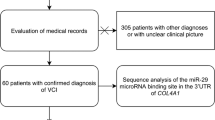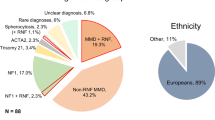Abstract
Cerebral autosomal dominant arteriopathy with subcortical infarcts and leukoencephalopathy (CADASIL) is a hereditary cerebral small vessel disease caused by NOTCH3, and characterized by recurrent cerebral ischemic events without vascular risk factors, mood disturbance, and dementia. MRI testing shows cerebral white matter hyperintensities, especially in the external capsule and temporal pole. Typical mutations are cysteine-related missense ones located in one of 34 EGF-like repeats (EGFr) in the NOTCH3 receptor. To identify genotype–phenotype correlations, 179 Japanese CADASIL probands were recruited. Of the 68 mutations identified, p.Cys388Arg, p.Cys435Phe, p.Gly481Cys, p.Cys743Tyr, and p.Cys1009Phe were novel ones. The genotype–phenotype correlation was analyzed based on the three most common mutations: p.Arg75Pro, p.Arg141Cys, and p.Arg182Cys. p.Arg141Cys showed typical CADASIL phenotypes, whereas p.Arg75Pro showed mild and atypical phenotypes, a low frequency of stroke/TIA, high frequency of hypertension, and low frequency of temporal pole lesions. p.Arg182Cys showed various initial symptoms other than stroke/TIA. Subsequently, we analyzed the effect of the mutation location on the age at onset of stroke/TIA. We found that mutations in EGFr 1–6 excluding the cysteine-sparing mutation p.Arg75Pro were significantly correlated with a younger age at onset of stroke/TIA compared with those in EGFr 7–34. This was in agreement with a recent European report, suggesting that the effect of the mutation location is a consensus finding in CADASIL worldwide.
This is a preview of subscription content, access via your institution
Access options
Subscribe to this journal
Receive 12 print issues and online access
$259.00 per year
only $21.58 per issue
Buy this article
- Purchase on Springer Link
- Instant access to full article PDF
Prices may be subject to local taxes which are calculated during checkout

Similar content being viewed by others
References
Chabriat H, Joutel A, Dichgans M, Tournier-Lasserve E, Bousser MG. Cadasil. Lancet Neurol. 2009;8:643–53.
Baudrimont M, Dubas F, Joutel A, Tournier-Lasserve E, Bousser MG. Autosomal dominant leukoencephalopathy and subcortical ischemic stroke. A clinicopathological study. Stroke. 1993;24:122–5.
Wang T, Baron M, Trump D. An overview of Notch3 function in vascular smooth muscle cells. Prog Biophys Mol Biol. 2008;96:499–509.
Joutel A, Vahedi K, Corpechot C, Troesch A, Chabriat H, Vayssiere C, et al. Strong clustering and stereotyped nature of Notch3 mutations in CADASIL patients. Lancet. 1997;350:1511–5.
Duering M, Karpinska A, Rosner S, Hopfner F, Zechmeister M, Peters N, et al. Co-aggregate formation of CADASIL-mutant NOTCH3: a single-particle analysis. Hum Mol Genet. 2011;20:3256–65.
Kim Y, Choi EJ, Choi CG, Kim G, Choi JH, Yoo HW, et al. Characteristics of CADASIL in Korea: a novel cysteine-sparing Notch3 mutation. Neurology. 2006;66:1511–6.
Mizuno T, Muranishi M, Torugun T, Tango H, Nagakane Y, Kudeken T, et al. Two Japanese CADASIL families exhibiting Notch3 mutation R75P not involving cysteine residue. Intern Med. 2008;47:2067–72.
Ueda A, Ueda M, Nagatoshi A, Hirano T, Ito T, Arai N, et al. Genotypic and phenotypic spectrum of CADASIL in Japan: the experience at a referral center in Kumamoto University from 1997 to 2014. J Neurol. 2015;262:1828–36.
Opherk C, Peters N, Herzog J, Luedtke R, Dichgans M. Long-term prognosis and causes of death in CADASIL: a retrospective study in 411 patients. Brain. 2004;127:2533–9.
Watanabe M, Adachi Y, Jackson M, Yamamoto-Watanabe Y, Wakasaya Y, Shirahama I, et al. An unusual case of elderly-onset cerebral autosomal dominant arteriopathy with subcortical infarcts and leukoencephalopathy (CADASIL) with multiple cerebrovascular risk factors. J Stroke Cerebrovasc Dis. 2012;21:143–5.
Mizuta I, Watanabe-Hosomi A, Koizumi T, Mukai M, Hamano A, Tomii Y, et al. New diagnostic criteria for cerebral autosomal dominant arteriopathy with subcortical infarcts and leukocencephalopathy in Japan. J Neurol Sci. 2017;381:62–7.
Rutten JW, Haan J, Terwindt GM, van Duinen SG, Boon EM, Lesnik Oberstein SA. Interpretation of NOTCH3 mutations in the diagnosis of CADASIL. Expert Rev Mol Diagn. 2014;14:593–603.
Liao YC, Hsiao CT, Fuh JL, Chern CM, Lee WJ, Guo YC, et al. Characterization of CADASIL among the Han Chinese in Taiwan: Distinct Genotypic and Phenotypic Profiles. PLoS ONE. 2015;10:e0136501.
Kim YE, Yoon CW, Seo SW, Ki CS, Kim YB, Kim JW, et al. Spectrum of NOTCH3 mutations in Korean patients with clinically suspicious cerebral autosomal dominant arteriopathy with subcortical infarcts and leukoencephalopathy. Neurobiol Aging. 2014;35:726 e1–6.
Rutten JW, Van Eijsden BJ, Duering M, Jouvent E, Opherk C, Pantoni L, et al. The effect of NOTCH3 pathogenic variant position on CADASIL disease severity: NOTCH3 EGFr 1-6 pathogenic variant are associated with a more severe phenotype and lower survival compared with EGFr 7–34 pathogenic variant. Genet Med. 2019;21:676–82.
Koizumi T, Mizuta I, Watanabe-Hosomi A, Mukai M, Hamano A, Matsuura J, et al. The CADASIL Scale-J, A Modified Scale to Prioritize Access to Genetic Testing for Japanese CADASIL-Suspected Patients. J Stroke Cerebrovasc Dis. 2019;28:1431–9.
Takeshi Y, Suda S, Shimoyama T, Aoki J, Suzuki K, Okubo S, et al. Cerebral autosomal dominant arteriopathy with subcortical infarcts and leukoencephalopathy associated with a novel in-frame mutation in the NOTCH3 gene in a Japanese patient. J Stroke Cerebrovasc Dis. 2019;104482. https://doi.org/10.1016/j.jstrokecerebrovasdi.
Kunii M, Doi H, Ishii Y, Ohba C, Tanaka K, Tada M, et al. Genetic analysis of adult leukoencephalopathy patients using a custom-designed gene panel. Clin Genet. 2018;94:232–8.
Ebihara Y, Mochizuki H, Ishii N, Mizuta I, Shiomi K, Mizuno T, et al. A Japanese Case of CADASIL with a Rare Mutation in Exon 24 of the NOTCH3 Gene. Intern Med. 2018;57:3011–4.
Mukai M, Mizuta I, Ueda A, Nakashima D, Kushimura Y, Noto YI, et al. A Japanese CADASIL patient with homozygous NOTCH3 p.Arg544Cys mutation confirmed pathologically. J Neurol Sci. 2018;394:38–40.
Rutten JW, Dauwerse HG, Gravesteijn G, van Belzen MJ, van der Grond J, Polke JM, et al. Archetypal NOTCH3 mutations frequent in public exome: implications for CADASIL. Ann Clin Transl Neurol. 2016;3:844–53.
Lee JS, Ko K, Oh JH, Park JH, Lee HK. Phenotypic features of cerebral autosomal-dominant arteriopathy with subcortical infarcts and leukoencephalopathy subjects with R544C mutation. Dement Neurocogn Disord. 2016;15:15–9.
Lek M, Karczewski KJ, Minikel EV, Samocha KE, Banks E, Fennell T, et al. Analysis of protein-coding genetic variation in 60,706 humans. Nature. 2016;536:285–91.
Auton A, Brooks LD, Durbin RM, Garrison EP, Kang HM, Korbel JO, et al. A global reference for human genetic variation. Nature. 2015;526:68–74.
Tadaka S, Katsuoka F, Ueki M, Kojima K, Makino S, Saito S, et al. 3.5KJPNv2: an allele frequency panel of 3552 Japanese individuals including the X chromosome. Hum Genome Var. 2019;6:28.
Tadaka S, Saigusa D, Motoike IN, Inoue J, Aoki Y, Shirota M, et al. jMorp: Japanese Multi Omics Reference Panel. Nucleic Acids Res. 2018;46:D551–D7.
Narayan SK, Gorman G, Kalaria RN, Ford GA, Chinnery PF. The minimum prevalence of CADASIL in northeast England. Neurology. 2012;78:1025–7.
Razvi SS, Davidson R, Bone I, Muir KW. The prevalence of cerebral autosomal dominant arteriopathy with subcortical infarcts and leucoencephalopathy (CADASIL) in the west of Scotland. J Neurol Neurosurg Psychiatry. 2005;76:739–41.
Bianchi S, Zicari E, Carluccio A, Di Donato I, Pescini F, Nannucci S, et al. CADASIL in central Italy: a retrospective clinical and genetic study in 229 patients. J Neurol. 2015;262:134–41.
Acknowledgements
We thank all the participants and their physicians. We also thank Hiromi Yasuike for technical support on conducting genetic analysis, and eigoclinic for English language editing. This study was supported by the Japan Agency for Medical Research and Development (AMED, 17ek0109130s0703), and by a grant-in-aid for Research on Intractable Disease from the Japanese Ministry of Health, Labour, and Welfare, Japan (H28-Nanchitou(Nan)-Ippan-029, H30-Nanchitou(Nan)-Ippan-006).
Author information
Authors and Affiliations
Corresponding author
Ethics declarations
Conflict of interest
The authors declare that they have no conflict of interest.
Additional information
Publisher’s note Springer Nature remains neutral with regard to jurisdictional claims in published maps and institutional affiliations.
Supplementary information
Rights and permissions
About this article
Cite this article
Mukai, M., Mizuta, I., Watanabe-Hosomi, A. et al. Genotype–phenotype correlations and effect of mutation location in Japanese CADASIL patients. J Hum Genet 65, 637–646 (2020). https://doi.org/10.1038/s10038-020-0751-9
Received:
Revised:
Accepted:
Published:
Issue Date:
DOI: https://doi.org/10.1038/s10038-020-0751-9
This article is cited by
-
Prevalence, clinical characteristics, and risk factors of intracerebral haemorrhage in CADASIL: a case series and systematic review
Journal of Neurology (2024)
-
Assessment of bidirectional relationships between brain imaging-derived phenotypes and stroke: a Mendelian randomization study
BMC Medicine (2023)
-
Exome-based gene panel analysis in a cohort of acute juvenile ischemic stroke patients:relevance of NOTCH3 and GLA variants
Journal of Neurology (2023)
-
Mutation spectrum and genotype–phenotype correlations in 157 Korean CADASIL patients: a multicenter study
neurogenetics (2022)



